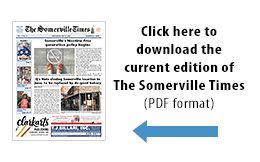(The opinions and views expressed in the commentaries and letters to the Editor of The Somerville Times belong solely to the authors and do not reflect the views or opinions of The Somerville Times, its staff or publishers)

By Will Mbah
Candidate for Somerville City Councilor at Large
In recent weeks, the City Council Land Use Committee has begun to discuss several proposed changes in the text of the Zoning Ordinance, which are intended to increase the numbers of housing units in transit-oriented zones.
These proposals involve two interrelated policy goals. First, they respond to the state mandate (adopted in the MBTA Communities Act of 2022) that requires all cities and towns, served by the MBTA, to permit some multi-family housing projects to be built by-right in zones near the transit stations. Second, they reflect a policy of Somerville leaders to go beyond the state mandate and create more opportunities for affordable housing projects, in particular, those that can offer 100% of their units as affordable.
Somerville already has in its Zoning Ordinance a number of mandates and incentives for developers to create more affordable housing units. The city has encouraged developers to combine zoning “bonuses” with tax exemptions, subsidies from state and federal grants, to deliver new units at affordable rents and prices. It has also made available city-owned land parcels for several projects.
Thus the changes, now being discussed, can be understood as the next steps in a series of city actions that have been gradually increasing the number of units in the total housing stock, which are fixed as affordable by deed restrictions and permit conditions.
The city has had to follow this incremental strategy because the state legislature has so far been unwilling to grant the city broader powers to regulate rents or tax real estate transfers as a way to provide housing subsidies. While we continue to advocate at the state level, we must work to find all the small opportunities to use our powers of zoning, city property management and taxation/spending to encourage affordable housing development and overall growth of the housing stock.
How does the Zoning Ordinance now encourage the development of affordable units and more units overall?
In 2015, the city undertook a study of the housing market and found that just over 10% of the 31,500 dwelling units in Somerville were affordable – about 3,340 units. It looked at the factors of projected population growth, incomes and housing cost inflation, and concluded that the city would need to grow its affordable component to about 9,000 units – that is, 20% of a future total stock of about 42,000 units.
To help move toward the goal, the mayoral agencies and City Council undertook a series of actions. First, in 2016, the Inclusionary Zoning requirements were raised from 13% to 20% of units in all new residential building with over 8 units. Then, when I was a member of the Council, we adopted additional programs and regulations:
- In 2018 we created the Community Land Trust to combine grant monies and tax incentives for 100% affordable projects.
- In 2019, in the revised Zoning Ordinance, we removed the need for small house projects (1-4 units) to get variances and special permits for non-complying yards, setbacks and other building dimensions.
- In 2020, we adopted the Affordable Housing Overlay Zone, which gives “bonus” height, density and adjustments of building dimensions for projects with 100% affordable units.
What will the new amendments do?
Today, the proposals before the Council will involve two stages. First, on October 19th the Land Use Committee and Planning Board will hear public testimony on twenty detailed text changes in the Zoning Ordinance Chapters on the low-density Neighborhood Residence and Urban residence zones. Subsequently, the Council will receive from the city planners more draft changes that will affect higher-scale residential projects in the Mid-Rise and Mixed-Use zones.
The proposed amendments for the Neighborhood Residence and Urban Residence zones will ensure that more houses with “extra” second or third units on the land parcel can be built, easily and without complex conditions.
For example, in the NR district, the Zoning Ordinance allows three dwelling units to be built on a lot if it has sufficient size for a double-decker with finished basement, a triple decker, or a main two-unit building with a third back-yard cottage. But there are limiting location and dimensional requirement:
- A triple-decker can only locate on a lot that is adjacent to or across the street from an existing triple-decker;
- A double- or triple-decker cannot be built on any lot that has less than 80 feet depth;
- If two or three dwelling units are combined on a lot they must be stacked in a double- or triple-decker house. They cannot be laid out horizontally one behind another.
- In both the NR and UR districts, the extra third unit must be fixed as affordable.
The proposed amendments remove these limiting requirements. This will mean that there will be a larger number of potential land parcels, potential building design solutions and potential financing scenarios, which can be built with three units.
For the zones with larger-scale residential projects, the intent of the City Council appears to be to make similar detailed adjustments of lot sizes, building heights, and configurations of units as “bonus” provisions for projects that will exceed the usual Inclusionary Housing requirement of 20% affordable units.
Are these changes to the Zoning Ordinance likely to produce some more affordable housing?
Based on the city’s past experience with incremental housing incentives, the answer to this question is yes. Each of the new tools, added since 2016, has resulted in some small gains.
For example, the Community Land Trust completed its first project in August 2022, when five affordable condo units at 7 Summer Street were designated by lottery to moderate-income buyers. Similarly, using the Affordable Housing Overlay regulations, there are now 16 affordable rental units getting ready for occupancy at 31 Tufts Street.
These results are not large numbers but, taken together, they are helping to make progress. In the absence of state action to give the city wider authority, these small incremental amendments deserve our attention and support.
If you want to learn more or support my campaign, please visit my website at willmbah.com.















Reader Comments